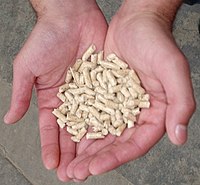
Photo from wikipedia
This study concentrated on the influence of rice husk biochar on the structural, thermal, flammable, and mechanical properties of recycled high-density polyethylene (HDPE). The percentage of rice husk biochar with… Click to show full abstract
This study concentrated on the influence of rice husk biochar on the structural, thermal, flammable, and mechanical properties of recycled high-density polyethylene (HDPE). The percentage of rice husk biochar with recycled HDPE was varied between 10% and 40%, and the optimum percentages were found for the various properties. Mechanical characteristics were evaluated in terms of the tensile, flexural, and impact properties. Similarly, the flame retardancy of the composites was observed by means of horizontal and vertical burning tests (UL-94 tests), limited oxygen index, and cone calorimetry. The thermal properties were characterized using thermogravimetric analysis (TGA). For detailed characterization, Fourier transform infrared spectroscopy (FTIR) and scanning electron microscopy (SEM) tests were performed, to elaborate on the variation in properties. The composite with 30% rice husk biochar demonstrated the maximum increase in tensile and flexural strength, i.e., 24% and 19%, respectively, compared to the recycled HDPE, whereas the 40% composite showed a 22.5% decrease in impact strength. Thermogravimetric analysis revealed that the 40% rice husk biochar reinforced composite exhibited the best thermal stability, due to having the highest amount of biochar. In addition, the 40% composite also displayed the lowest burning rate in the horizontal burning test and the lowest V-1 rating in the vertical burning test. The 40% composite material also showed the highest limited oxygen index (LOI), whereas it had the lowest peak heat release rate (PHRR) value (52.40% reduced) and total heat release rate (THR) value (52.88% reduced) for cone calorimetry, when compared with the recycled HDPE. These tests proved that rice husk biochar is a significant additive for enhancing the mechanical, thermal, and fire-retardant properties of recycled HDPE.
Journal Title: Polymers
Year Published: 2023
Link to full text (if available)
Share on Social Media: Sign Up to like & get
recommendations!